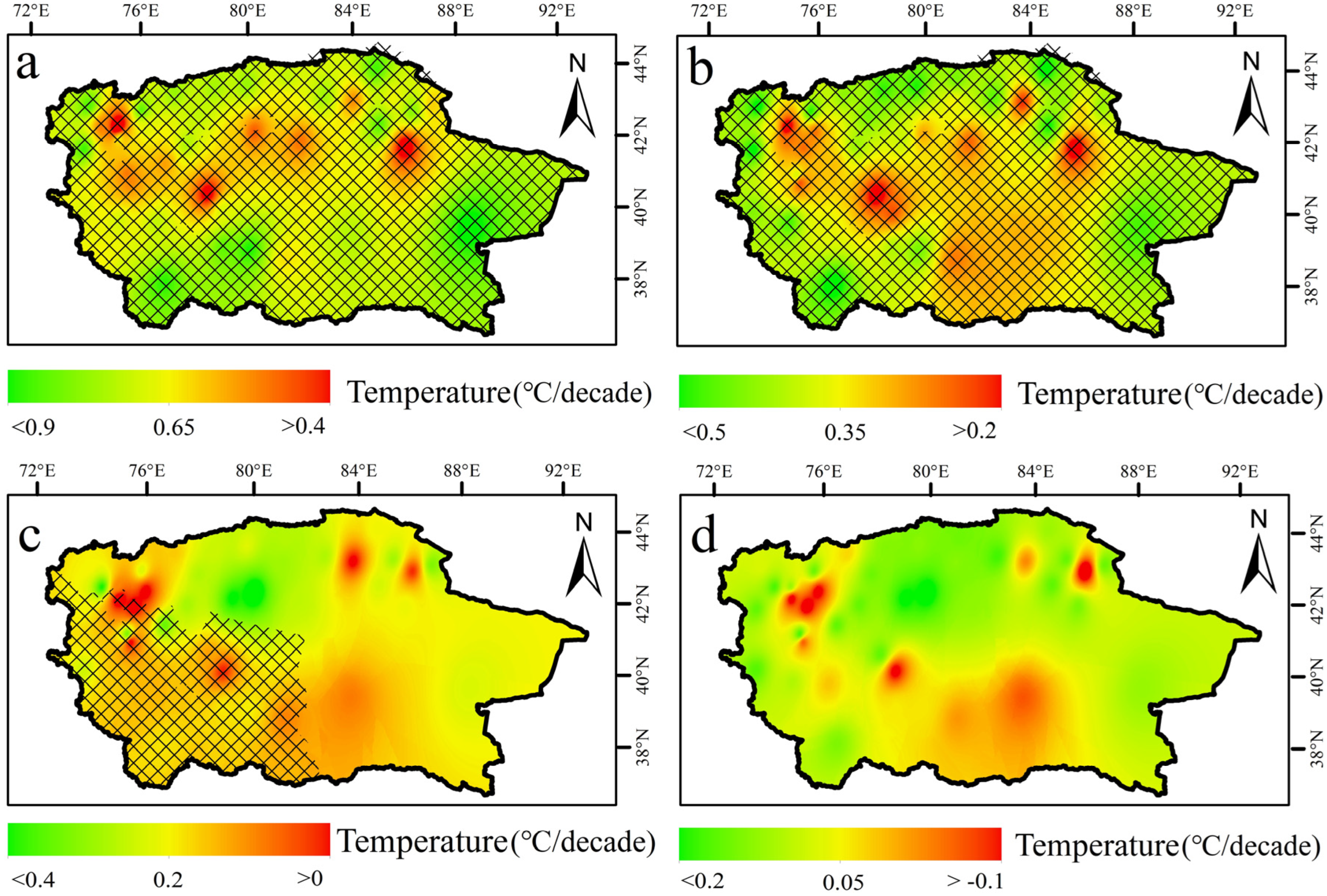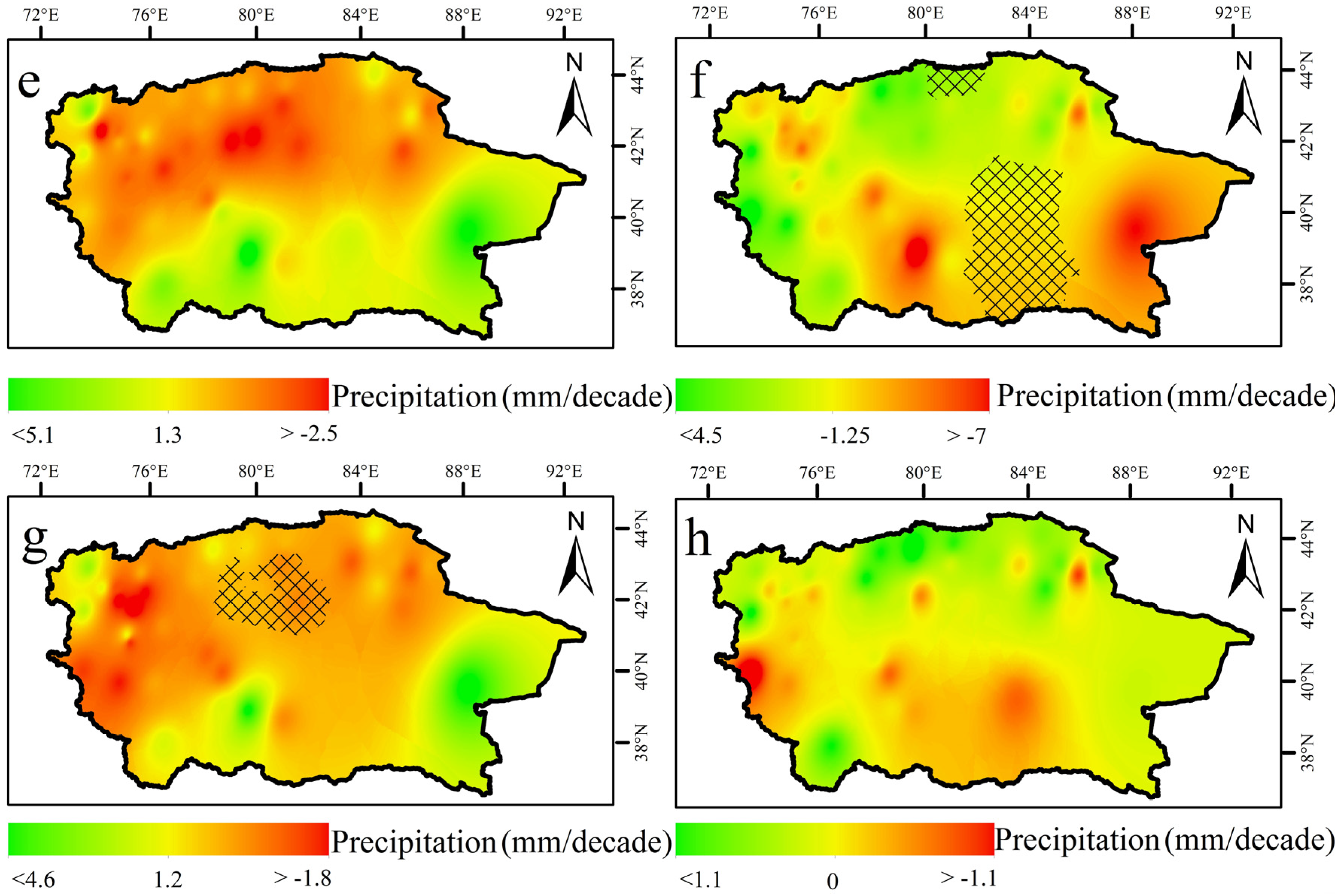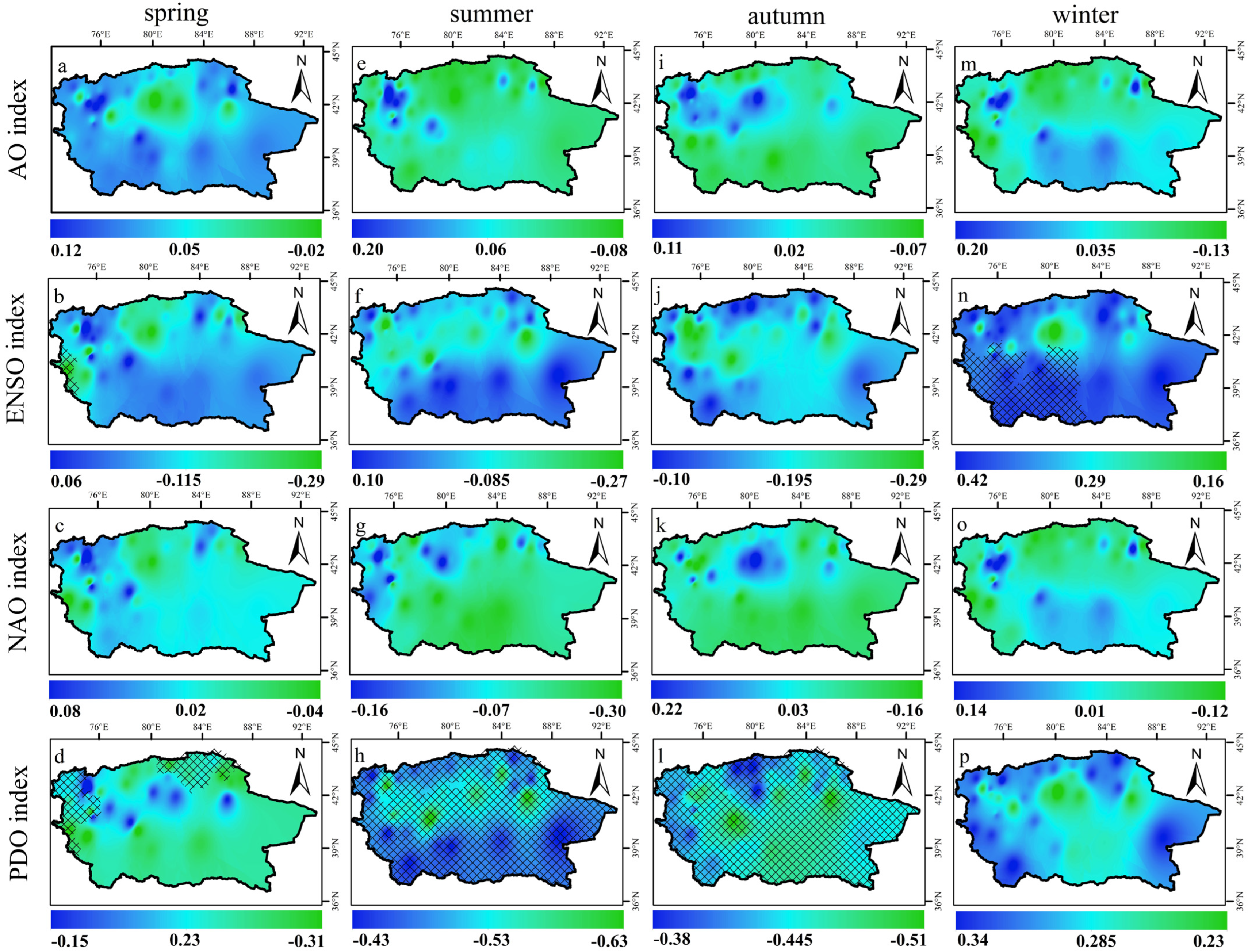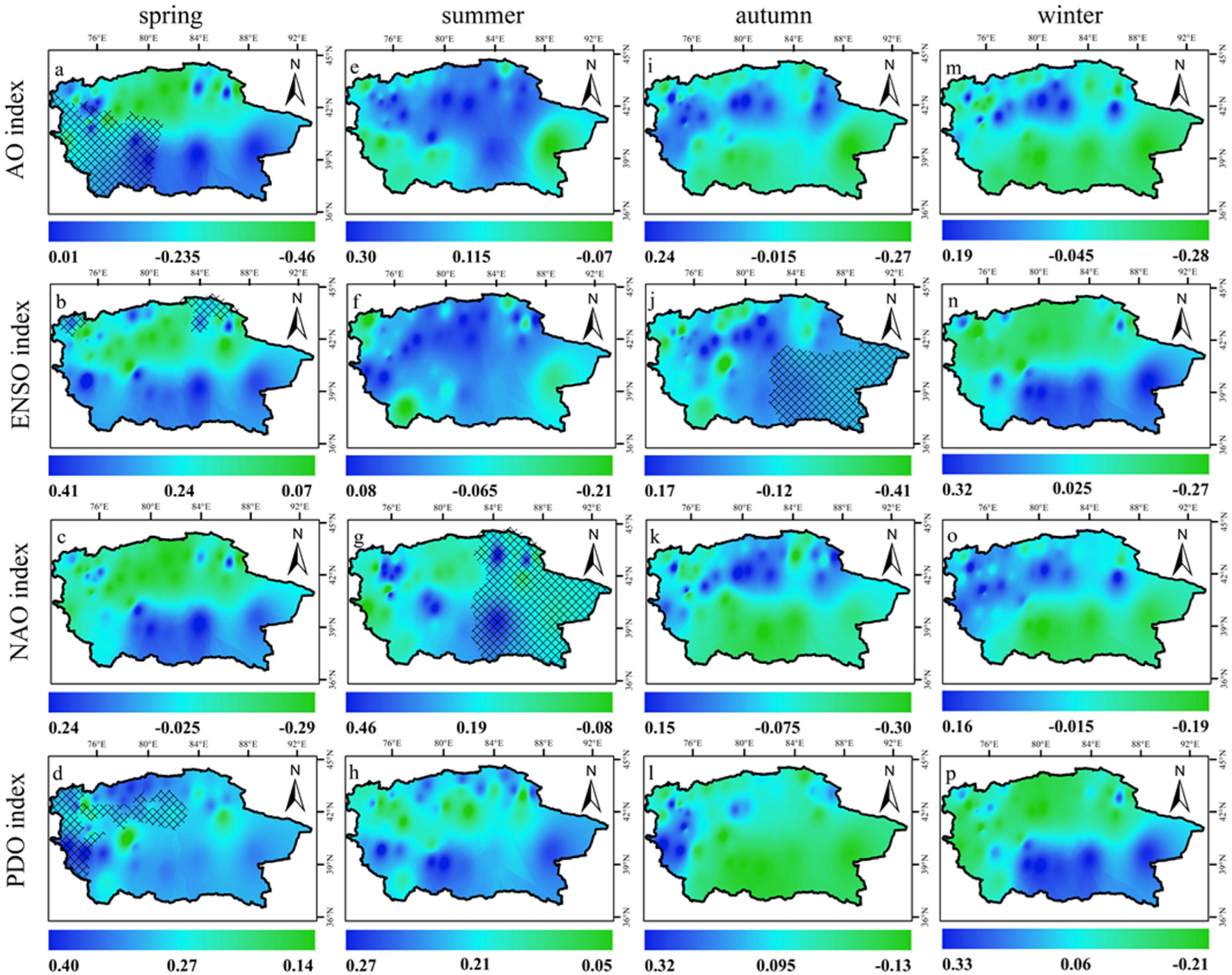Spatiotemporal Characteristics of Watershed Warming and Wetting: The Response to Atmospheric Circulation in Arid Areas of Northwest China
Abstract
:1. Introduction
2. Materials and Methods
2.1. Study Area and Data Sources
2.2. Research Methods
2.2.1. Analysis of Change Trend
2.2.2. Spatial Interpolation Method
2.2.3. Wavelet Analysis
2.2.4. Correlational Analysis
3. Results
3.1. Temporal Characteristics of Climate Change in the Tarim Basin
3.2. Spatial Characteristics of Climate Change in the Tarim Basin
3.3. Climate Change and Atmospheric Circulation in the Tarim Basin
3.3.1. The Seasonal Temperature and Atmospheric Circulation in the Tarim Basin
3.3.2. The Seasonal Precipitation and Atmospheric Circulation in the Tarim Basin
4. Discussion
4.1. Spatiotemporal Characteristics of Climate Change in the Tarim Basin
4.2. Climate Evolution in the Tarim Basin: Effect of Atmospheric Circulation
5. Conclusions
- (1)
- The Tarim Basin experienced a significant, seasonally specific warming and wetting phenomenon from 1987 to 2020. All areas of the Tarim Basin warmed significantly in all seasons over this period, whereas the precipitation differed significantly across the seasons. The climate of the basin and the atmospheric circulation both oscillated over a period of 17–20 years, which indicates that the atmospheric circulation is involved in the generation of the wetting phenomenon of the Tarim Basin. Moreover, the spatiotemporal evolution of climate change in the Tarim Basin still follows its original climate type, despite experiencing a warming and wetting phenomenon over the study period. Because the two indices of temperature and precipitation were studied by statistical methods in this paper, the research results are weak in explaining the mechanism. In future studies, we need to consider using different indicators (such as the Drought Index, Drought Frequency, and Normalized Difference Vegetation Index) to explore the characteristics of climate change in the Tarim Basin at the seasonal scale.
- (2)
- Seasonal temperature (precipitation) and the corresponding atmospheric circulation indexes are relatively low (α = 0.05) in most regions of the Tarim Basin. PDO is the leading factor of summer and autumn climate change in the Tarim Basin, and ENSO also plays an important role in spring and winter climate change. However, the teleconnection effect of atmospheric circulation on precipitation in the Tarim Basin is relatively low. The results show that atmospheric circulation is only one of the dominant factors contributing to the warm and wet phenomenon in the Tarim Basin. For example, extreme precipitation events may be the main cause of the wetting phenomenon in the Tarim Basin. Therefore, because the actual physical mechanism in the Tarim Basin is complicated, many internal factors need to be considered in future research.
Author Contributions
Funding
Data Availability Statement
Acknowledgments
Conflicts of Interest
References
- Shi, Y.; Shen, Y.; Li, D.; Zhang, G.; Ding, Y.; Hu, R.; Kang, E. Discussion on the present climate change from warm-dry to warm wet in northwest China. Quat. Sci. 2003, 23, 152–164. [Google Scholar]
- Wu, P.; Ding, Y.; Liu, Y.; Li, X. The characteristics of moisture recycling and its impact on regional precipitation against the background of climate warming over Northwest China. Int. J. Climatol. 2019, 39, 5241–5255. [Google Scholar] [CrossRef]
- Wang, C.; Zhang, S.; Zhang, F.; Li, K.; Yang, K. On the increase of precipitation in the northwestern China under the global warming. Adv. Earth Sci. 2021, 36, 980–989. [Google Scholar]
- Lv, A.; Qu, B.; Jia, S.; Zhu, W. Influence of three phases of El Niño–Southern Oscillation on daily precipitation regimes in China. Hydrol. Earth Syst. Sci. 2019, 23, 883–896. [Google Scholar] [CrossRef] [Green Version]
- Yao, J.Q.; Li, M.Y.; Dilinuer, T.; Chen, J.; Mao, W. The assessment on “warming-wetting” trend in Xinjiang at multi-scale during 1961–2019. Arid Zone Res. 2022, 39, 333–346. [Google Scholar]
- Li, M.; Sun, H.Q.; Su, Z.C. Research progress in dry/wet climate variation in northwest China. Geogr. Res. 2021, 40, 1180–1194. [Google Scholar]
- Hou, Y.; Chen, Y.; Ding, J.; Li, Z.; Li, Y.; Sun, F. Ecological Impacts of Land Use Change in the Arid Tarim River Basin of China. Remote Sens. 2022, 14, 1894. [Google Scholar] [CrossRef]
- Bai, J.; Li, J.; Bao, A.; Chang, C. Spatial-temporal variations of ecological vulnerability in the Tarim River Basin, Northwest China. J. Arid Land 2021, 13, 814–834. [Google Scholar] [CrossRef]
- Wang, G.Y.; Wang, Y.J.; Gui, D.W. A review on water resources research in Tarim river basin. Arid Land Geogr. 2018, 41, 1151–1159. [Google Scholar]
- Ren, Q.; Long, A.H.; Yang, Y.M. Analysis on remote sensing monitoring of eco-environment variationof main stream basin of Tarim river in recent 20 years. Water Resour. Hydropower Eng. 2021, 52, 103–111. [Google Scholar]
- Liu, Q.; Liu, Y.; Niu, J.; Gui, D.; Hu, B.X. Prediction of the Irrigation Area Carrying Capacity in the Tarim River Basin under Climate Change. Agriculture 2022, 12, 657. [Google Scholar] [CrossRef]
- Li, H.; Wang, W.; Fu, J.; Chen, Z.; Ning, Z.; Liu, Y. Quantifying the relative contribution of climate variability and human activities impacts on baseflow dynamics in the Tarim River Basin, Northwest China. J. Hydrol. Reg. Stud. 2021, 36, 100853. [Google Scholar] [CrossRef]
- Han, Y.; Zhang, S.; Lv, A.F.; Zeng, H. Risk Assessment of Water Resources Carrying Capacity in China. JAWRA J. Am. Water Resour. Assoc. 2021, 57, 539–551. [Google Scholar] [CrossRef]
- Chen, Y.; Deng, H.; Li, B.; Li, Z.; Xu, C. Abrupt change of temperature and precipitation extremes in the arid region of Northwest China. Quat. Int. 2014, 336, 35–43. [Google Scholar] [CrossRef]
- Li, B.; Chen, Y.; Shi, X.; Chen, Z.; Li, W. Temperature and precipitation changes in different environments in the arid region of northwest China. Theor. Appl. Climatol. 2013, 112, 589–596. [Google Scholar] [CrossRef]
- Yang, H.; Xu, J.; Chen, Y.; Li, D.; Zuo, J.; Zhu, N.; Chen, Z. Has the Bosten Lake Basin been dry or wet during the climate transition in North -west China in the past 30 years? Theor. Appl. Climatol. 2020, 141, 627–644. [Google Scholar] [CrossRef]
- Zhang, Q.; Zhu, B.; Yang, J.; Ma, P.; Liu, X.; Lu, G.; Wang, Y.; Yu, H.; Liu, W.; Wang, D. New characteristics about the climate humidification trend in northwest China. Chin. Sci. Bull. 2021, 66, 3757–3771. [Google Scholar] [CrossRef]
- Gessner, U.; Naeimi, V.; Klein, I.; Kuenzer, C.; Klein, D.; Dech, S. The relationship between precipitation anomalies and satellite-derived vegetation activity in Central Asia. Glob. Planet. Change 2013, 110, 74–87. [Google Scholar] [CrossRef]
- Botne, O.; Fraedrich, K.; Zhu, X. Precipitation climate of Central Asia and the large-scale atmospheric circulation. Theor. Appl. Climatol. 2012, 108, 345–354. [Google Scholar]
- Jiang, J.; Zhou, T.; Chen, X.; Zhang, L. Future changes in precipitation over Central Asia based on CMIP6 projections. Environ. Res. Lett. 2020, 15, 054009. [Google Scholar] [CrossRef]
- Wang, H.; He, M.; Yan, W.; Ai, J.; Chu, J. Ecosystem vulnerability in the tianshan mountains and Tarim oasis based on remote sensed gross primary productivity. Acta Ecol. Sin. 2021, 41, 9729–9737. [Google Scholar]
- Fan, L.; Lv, A.F.; Zhang, W.X. Temporal-spatial variation characteristics of drought and its relationship with atmospheric circulation in qinghai province. J. Arid Land Resour. Environ. 2021, 35, 60–65. [Google Scholar]
- Ma, Z.G.; Fu, Z.B. The facts of global aridity in the second half of the 20th Century and its connection to the large-scale context. Sci. Sin. (Terrae) 2007, 37, 222–233. [Google Scholar]
- Guan, X.D.; Huang, J.P.; Guo, R.X. Changes in Aridity in Response to the Global Warming Hiatus. J. Meteorol. Res. 2017, 31, 117–125. [Google Scholar] [CrossRef]
- Zhou, H.; Shen, M.; Chen, J.; Xia, J.; Hong, S. Trends of natural runoffs in the Tarim river basin during the last 60 years. Arid. Land Geogr. 2018, 41, 221–229. [Google Scholar]
- Zhang, Y.L.; Chen, Y.N.; Yang, Y.H.; Hao, X.M. Analysis of historical change and future trends Tarim river. Arid Land Geography. 2016, 39, 582–589. [Google Scholar]
- Song, C.H. Research on adjusting effect for different mathe matical model of precipitation series. J. Appl. Meteorol. Sci. 1998, 9, 86–91. [Google Scholar]
- Li, X.Y.; Huang, S.P.; Ye, H.; Xiong, Y.Z.; Chen, F.; Wang, K.; Pan, L.Y. Comparison characteristics andinhomogeneity adjustments of mean, maximum and minimum surface air temperature for Xiamen meteorological station. Sci. Geogr. Sin. 2010, 30, 796–801. [Google Scholar]
- Zhu, J.J.; Zhang, C.Y.; Wang, W.; Li, C. Analysis of correlation between groundwater, air pressure and precipitation in plain areas of Hubei and Hunan province. Sci. Surv. Mapp. 2015, 40, 7–11. [Google Scholar]
- Li, Z.Q.; Wu, Y.X. Inverse Distance Weighted Interpolation Involving Position Shading. Acta Geod. Et Cartogr. Sin. 2015, 44, 91–98. [Google Scholar]
- Souza Echer, M.P.; Echer, E.; Nordemann, D.J.; Rigozo, N.R.; Prestes, A. Wavelet analysis of a centennial (1895–1994) southern Brazil rainfall series (Pelotas, 31°46′19″ S 52°20′33″ W). Clim. Chang. 2008, 87, 489–497. [Google Scholar] [CrossRef]
- Kumar, P. Foufoula-Georgiou, E. Wavelet analysis in geophysics: An introduction. Wavelets Geophys. 1994, 4, 1–43. [Google Scholar]
- Xu, J.H. Mathematical Methods in Modern Geography; Higher Education Press: Beijing, China, 1996. [Google Scholar]
- Huang, J.Y. Meteorological Statistical Analysis and Forecasting Methods; China Meteorological Press: Beijing, China, 2004; pp. 28–30. [Google Scholar]
- Zhang, W.; Bao, W.M.; Feng, X.Q.; Lu, J.L.; Luo, Q.F. Study on the change of meteorological elements in Tarim river basin in recent 50 years. Water Power 2020, 46, 28–34. [Google Scholar]
- Fu, A.H.; Chen, Y.N.; Li, W.H. Assessment on ecosystem health in the Tarim river basin. Acta Ecol. Sin. 2009, 29, 2418–2426. [Google Scholar]
- Kong, Z.J.; Deng, M.J.; Ling, H.B.; Wang, G.Y.; Xu, S.W.; Wang, Z.R. Ecological security assessment and ecological restoration countermeasures in the dry-uparea of the lower Tarim river. Arid Zone Res. 2021, 38, 1128–1139. [Google Scholar]
- Chen, Y.N.; Li, Z.; Fan, Y.T.; Wang, H.J.; Fang, G.H. Research progress on the impact of climate change on water resources in the arid region of northwest China. Acta Geogr. Sin. 2014, 69, 1295–1304. [Google Scholar]
- Wei, G.H.; Yang, P.; Zhou, H.Y.; Xia, J.; Chen, J.; Gui, D.W.; Bayindala. An analysis of the drought characteristics and driving factors of Tarim river basin based on downscaled terrestrial water storage from GRACE. China Rural Water Hydropower 2020, 7, 12–19. [Google Scholar]
- Tao, H.; Bai, Y.G.; Mao, W.Y. Observed and projected climate changes in Tarim river basin. J. Glaciol. Geocryol. 2011, 33, 738–743. [Google Scholar]
- Chen, L.; Wang, S.G.; Shang, K.Z.; Yang, D.B. Atmospheric circulation anomalies of large-scale extreme high temperature events in northwest China. J. Desert Res. 2011, 31, 1052–1058. [Google Scholar]
- Gao, M.; Yang, J.; Gong, D.; Shi, P.; Han, Z.; Kim, S.J. Footprints of Atlantic Multidecadal Oscillation in the Low-Frequency Variation of Extreme High Temperature in the Northern Hemisphere. J. Clim. 2019, 32, 791–802. [Google Scholar] [CrossRef]
- Liu, Y.; Wu, C.; Jia, R.; Huang, J. An overview of the influence of circulation on the climate in arid and semi-arid region of central and east asia. Sci. Sin. (Terrae) 2018, 48, 1141–1152. [Google Scholar] [CrossRef]
- Huang, J.; Guan, X.; Ji, F. Enhanced cold-season warming in semi-arid regions. Atmos. Chem. Phys. 2012, 12, 5391–5398. [Google Scholar] [CrossRef]







Disclaimer/Publisher’s Note: The statements, opinions and data contained in all publications are solely those of the individual author(s) and contributor(s) and not of MDPI and/or the editor(s). MDPI and/or the editor(s) disclaim responsibility for any injury to people or property resulting from any ideas, methods, instructions or products referred to in the content. |
© 2023 by the authors. Licensee MDPI, Basel, Switzerland. This article is an open access article distributed under the terms and conditions of the Creative Commons Attribution (CC BY) license (https://creativecommons.org/licenses/by/4.0/).
Share and Cite
Li, T.; Lv, A.; Zhang, W.; Liu, Y. Spatiotemporal Characteristics of Watershed Warming and Wetting: The Response to Atmospheric Circulation in Arid Areas of Northwest China. Atmosphere 2023, 14, 151. https://doi.org/10.3390/atmos14010151
Li T, Lv A, Zhang W, Liu Y. Spatiotemporal Characteristics of Watershed Warming and Wetting: The Response to Atmospheric Circulation in Arid Areas of Northwest China. Atmosphere. 2023; 14(1):151. https://doi.org/10.3390/atmos14010151
Chicago/Turabian StyleLi, Taohui, Aifeng Lv, Wenxiang Zhang, and Yonghao Liu. 2023. "Spatiotemporal Characteristics of Watershed Warming and Wetting: The Response to Atmospheric Circulation in Arid Areas of Northwest China" Atmosphere 14, no. 1: 151. https://doi.org/10.3390/atmos14010151
APA StyleLi, T., Lv, A., Zhang, W., & Liu, Y. (2023). Spatiotemporal Characteristics of Watershed Warming and Wetting: The Response to Atmospheric Circulation in Arid Areas of Northwest China. Atmosphere, 14(1), 151. https://doi.org/10.3390/atmos14010151







